BEST Gluten-Free Pie Crust Recipe: Quick, Flaky & Easy!
This gluten-free pie crust is, well… easy as pie! And every bit as delicious and flaky as a regular wheat flour pie crust.
Unlike bread, the magic in pie crust is not in the gluten. The magic is in the fat. This makes it fairly easy to replicate in a gluten-free version.
In fact, gluten can be overworked and “over-watered” resulting in a tough pie crust. Without the added structure of gluten, this easy gluten-free pie crust is always exceptionally tender and flaky.
Some of the links on this post are affiliate links. To learn more, visit our Disclosures.
Here’s why you’ll love this homemade pie crust:
- It’s flaky and delicious. The rich buttery bits in the dough melt into a perfect, flaky pie crust, every bit as good as your grandma’s traditional pie crust. No one will ever know it isn’t a “regular” pie crust.
- It’s so easy! Pie crusts have developed a reputation for being intimidating. While there are a couple of essential elements, it’s not complicated. Just follow these simple directions and in ten minutes you’ll have two pie crust disks chilling in your fridge waiting to be rolled out and filled with your favorite pie filling.
- You can make it ahead. The pie crust dough will keep in the fridge for up to two days and in the freezer for up to three months.
- The recipe makes two crusts. That’s enough for one double-crust pie or two single-crust pies. One of my favorite uses is “one now and one later”. For example, use one crust for a Thanksgiving pumpkin pie, and the other to top a leftover turkey pot pie the day after Thanksgiving. So many good excuses for pie!
- You only need four ingredients that already are (or should be) staples in your gluten-free kitchen. Meaning, you can enjoy this pie crust anytime!
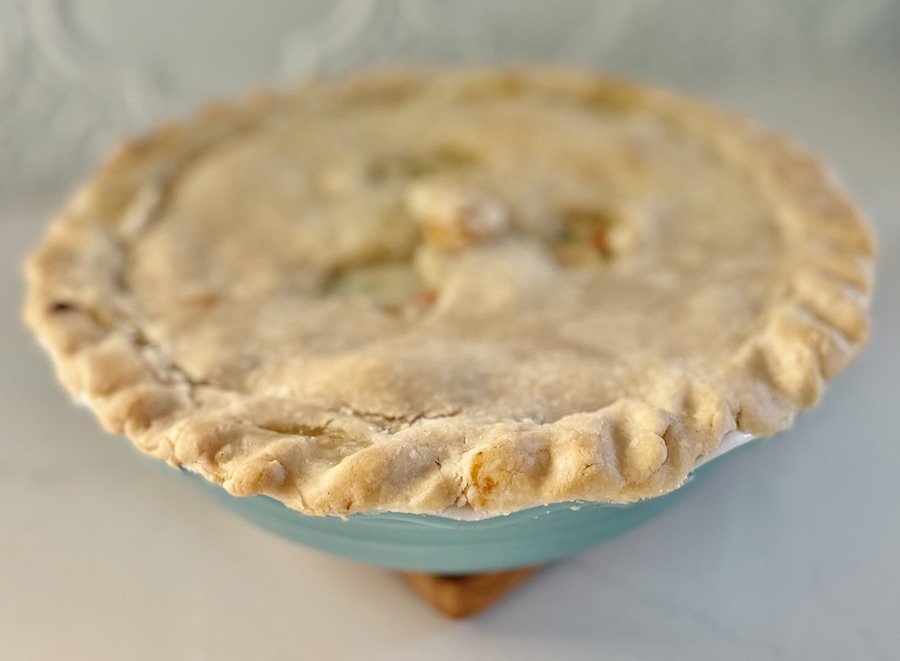
Four Simple Ingredients
Cold Unsalted Butter: the most important ingredient for achieving a flaky pie crust. Start with cold butter, and follow the recipe instructions to keep the butter cold all along the way. When the butter melts during baking, it will leave behind pockets of air and a perfectly flaky crust.
This recipe calls for unsalted butter. If using salted butter, reduce the salt to ½ teaspoon.
King Arthur’s Gluten-Free Measure for Measure Flour: an easy-to-use, gluten-free baking flour that can often be swapped 1-to-1 for regular flour in your favorite non-yeasted recipes. This is my favorite 1-to-1 gluten-free substitute flour.
It includes xanthan gum, an important binder in gluten-free dough. The ingredients are heavier on whole grains over starches than other 1-to-1 replacement flours. Plus, it includes a vitamin and mineral blend. Most importantly, the results in baking are excellent across the board.
King Arthur Gluten-Free Measure for Measure Flour ingredients: rice flour, whole grain brown rice flour,sorghum flour, tapioca starch, potato starch, vitamin and mineral blend [calcium carbonate, niacinamide (vitamin B3), reduced iron, thiamin hydrochloride (vitamin B1), Riboflavin (vitamin B2)], xanthan gum, and cellulose gum.
Salt: a critical ingredient in pie crust. Without salt, your crust will taste bland. Even in sweet pies, the salty crust compliments the sugary sweetness for the best flavor.
Water: needs to be ice-cold water. Place water and ice in a cup for at least a minute to get it ice cold. I make my ice water right after I cut the butter into cubes, giving it time to chill while I mix the other ingredients.
Instructions for Making Gluten-Free Pie Crust Dough
Cut the butter into small ½-inch cubes. Place the butter cubes in the freezer while prepping and measuring other ingredients. The butter will soften slightly when you cut the cubes. Returning it briefly to the freezer will help it stay cold, which is essential for a flaky crust.

Add flour and salt to a large mixing bowl. To accurately measure gluten-free flour, spoon it into your measuring cup and sweep the excess flour off the top with the back edge of a knife. Stir the flour and salt with a whisk to combine.


Add cold butter cubes to the flour-salt mixture. Use a pastry cutter to cut the butter into the dry ingredients. Do not over-mix. The dough should be rough and crumbly with pea-sized chunks.
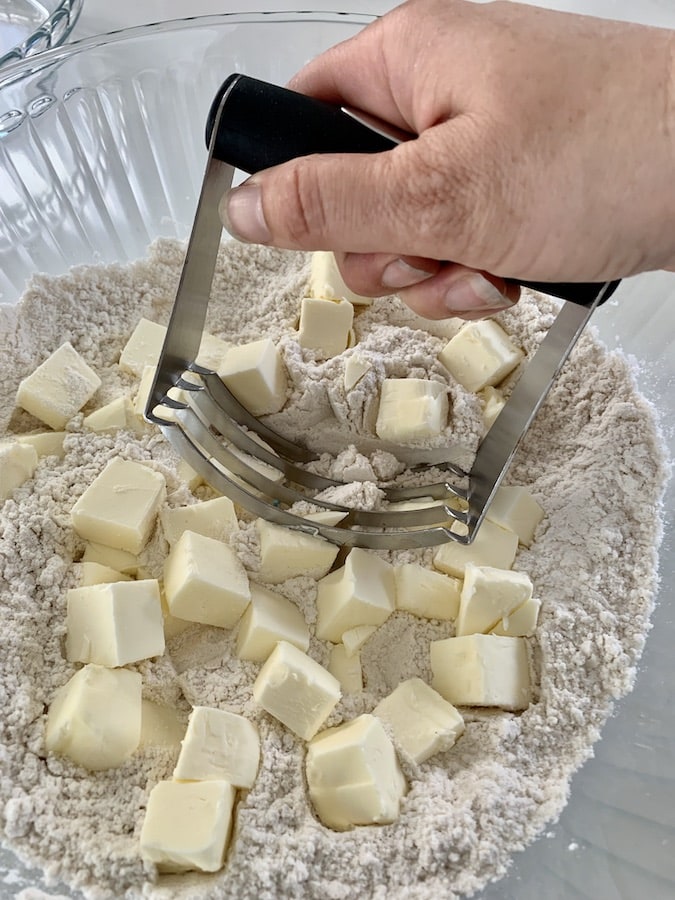
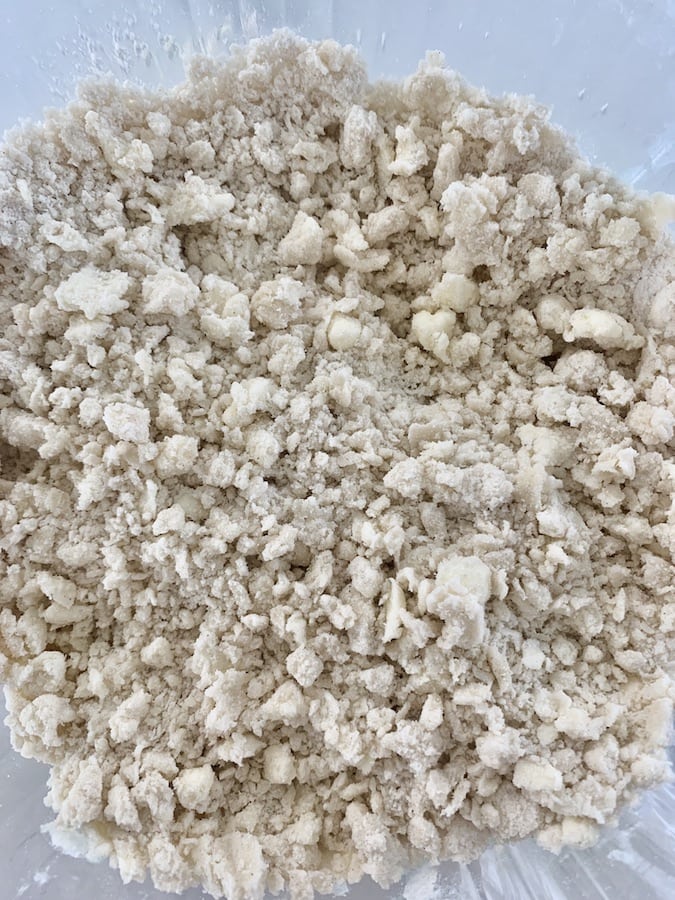
Slowly drizzle 5 tablespoons of ice-cold water onto the mixture. Stir just enough to combine.

The dough should still be rough and crumbly, but not wet. It should easily press together with the consistency of cookie dough. If needed to hold the dough together, add the remaining 1-2 tablespoons of ice water.
I think this recipe is perfect with 5 tablespoons of water, but don’t worry if you need the extra water. When baking regular pie crust, you have to be very careful not to add too much water, or it will activate the gluten and create too much structure and a tough crust.
Not so with gluten-free pie dough! Add what you need to be able to roll the dough out. You just don’t want it to be difficult to work with and sticky.

Use your hands to form a dough ball. Put the dough ball on the counter. Divide in two. If making a double-crust pie, you can opt to add a little more dough to one “half”, allowing for more dough to roll out a larger bottom crust.
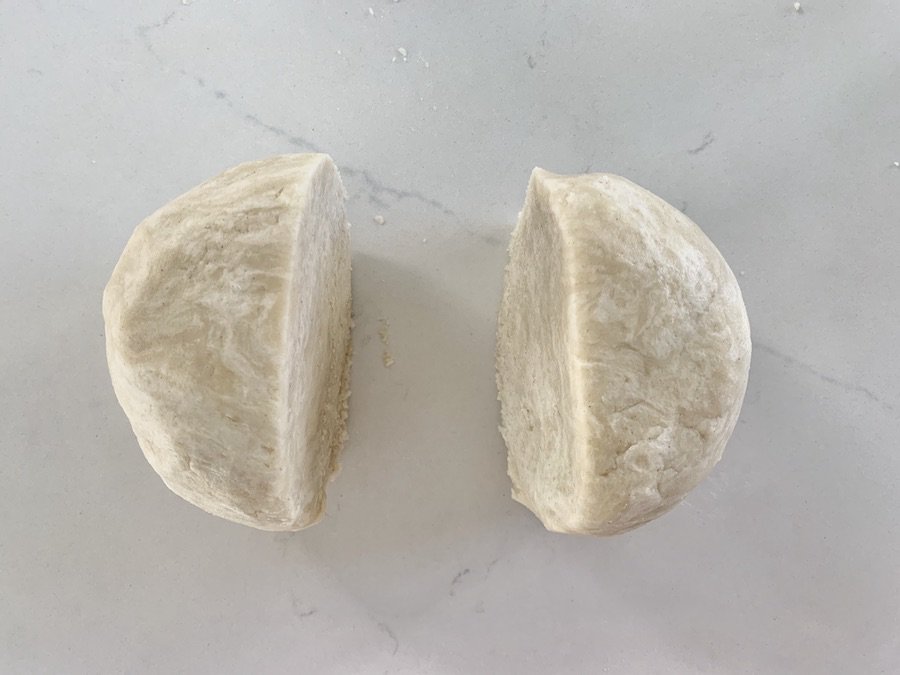
Press each half into a flat disk about 1″ thick.
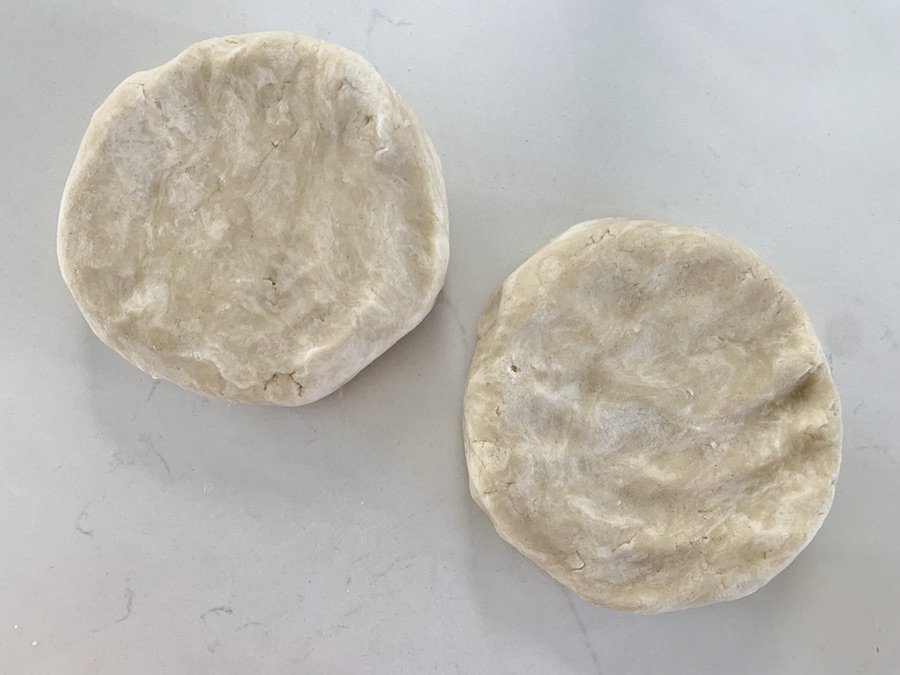
Wrap each disk tightly in plastic wrap and store in the fridge for one hour (up to two days) before rolling out your pie crust. You can store the dough in the freezer for up to three months. Simply move it to the fridge the day before you plan to use it.
Roll out dough, fill, and bake according to the instructions for your pie recipe.
Instructions to Parbake Bottom Crust
Parbaking a pie crust is simply partially (“par”) baking the bottom crust of the pie before adding the wet filling, so it sets and doesn’t get soggy. For the best results, I recommend quick parbaking when making a pie with a custard (like pumpkin pie) or fresh fruit filling.
Preheat oven to 450℉. Using parchment paper and a light dusting of flour, roll out one refrigerated pie crust.

Work quickly. If the dough starts to get too soft, return it to the refrigerator for a few minutes to firm up. Use dough from the edges to patch any breaks or tears. Imperfections will be hidden under the pie filling.
Roll out the dough until it is approximately 12″ round and place in a pie dish. Gently press the dough down so that it is fully set into the bottom edges of the pan.
For a double-crust pie, remove the excess pie crust from the edges of your pie pan. There’s no need to make a decorative edge, as you will do that later with your top crust.
For a single-crust pie, make a decorative edge. Cut any excess crust to about ½ inch from the edges of the pie pan. Fold the edges of the crust to create a tall thick border. Press the side of your pinky or thumb into the crust at an angle, repeating around the entire edge. Or crimp with a fork or decorate as you wish.
Poke the bottom of the crust with a fork to prevent it from puffing up while baking.
If using a metal pie pan, place the pie crust in the refrigerator for 10 minutes, to firm up the dough, again. Skip this step if you are using a glass/Pyrex pan, as Pyrex is not designed to go from a cold fridge to a hot oven. What little you give up in crust quality is worth it not to have a glass explosion in your oven.
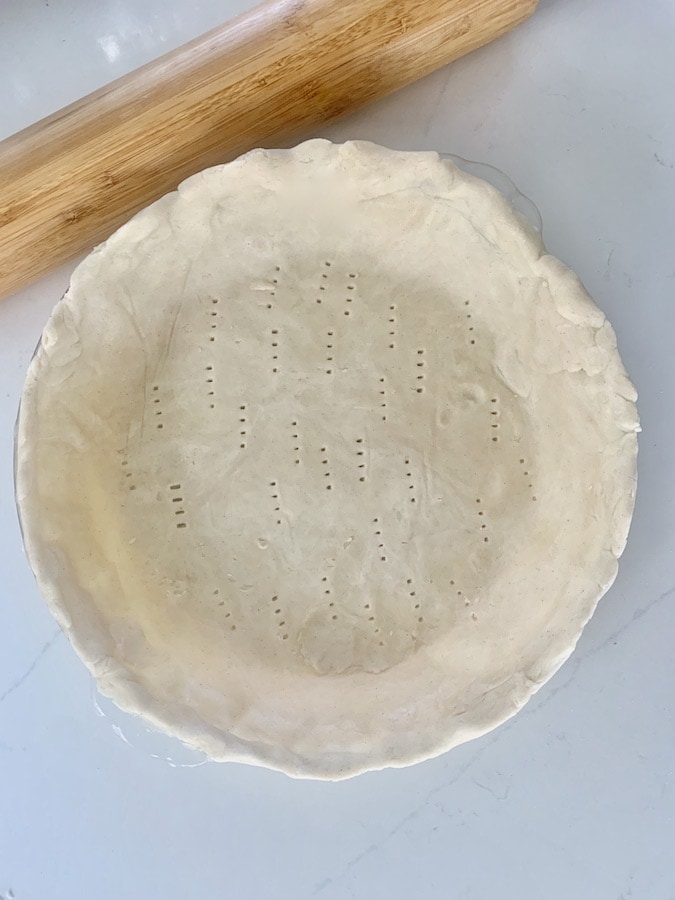
Before baking, cover the edges with a pie shield to prevent burning. Put the pie pan on a baking sheet, for more even baking of the crust base. Place in the bottom third of the oven and bake for 10 minutes at 450℉.
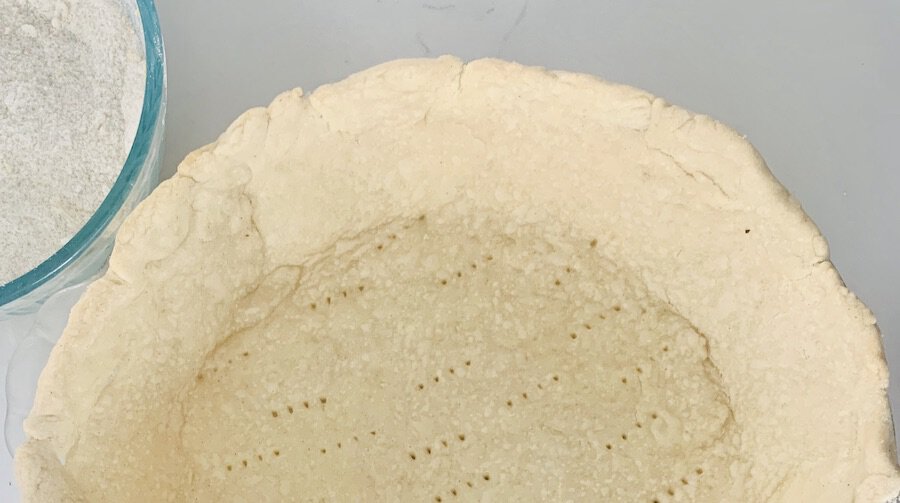
Then, fill and bake according to the instructions for your pie recipe.
Great Recipes That Use Gluten-Free Pie Crust:
- Gluten-Free Apple Galette
- Gluten-Free Turkey Pot Pie (Easy 1-Skillet Recipe)
- Gluten-Free Strawberry Rhubarb Pie
- Gluten-Free Chicken Pot Pie
FAQs
You will love this gluten-free crust recipe! Happy baking!
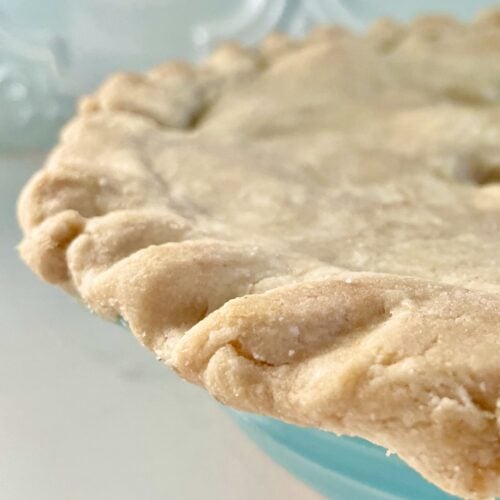
Gluten-Free Pie Crust Recipe
Ingredients
- 1 cup cold unsalted butter
- 2 ½ cups King Arthur Gluten-Free Measure for Measure Flour plus extra for dusting when rolling out crust
- 1 teaspoon salt
- 5-7 tablespoons ice water
Instructions
Pie Crust Dough
- Cut butter into small ½-inch cubes. Place butter cubes in the freezer while prepping and measuring other ingredients.
- Add flour and salt to a large mixing bowl. Stir with a whisk to combine.
- Add cold butter cubes to flour-salt mixture. Use a pastry cutter to cut the butter into the mixture. Do not over-mix. The dough should be rough and crumbly with pea-sized chunks.
- Slowly drizzle 5 tablespoons of ice-cold water onto mixture. Stir just enough to combine. Dough should still be rough and crumbly, not wet, but will easily press together with the consistency of cookie dough. If needed to hold the dough together, add remaining 1-2 tablespoons of ice water. Use your hands to form a dough ball.
- Put dough ball on the counter. Divide in two. Then press each half into a flat disk about 1" thick.
- Wrap each disk in plastic wrap and store in the fridge for 1 hour (up to 2 days) before rolling out your pie crust.
- Roll out dough, fill, and bake according to the instructions for your pie recipe.
Parbake Bottom Crust (recommended for fresh fruit or custard pie fillings)
- Preheat oven to 450℉.
- Using parchment paper and a light dusting of flour, roll out 1 pie crust and place in pie dish. Gently press dough down so that it is fully set into the bottom edges of the pan.
- Double-crust pie: remove excess pie crust from edges of pie pan. Single-crust pie: make a decorative edge. Cut excess crust to about ½ inch from edges of pie pan. Fold edges of the crust to create a tall thick border. Press the side of your pinky or thumb into the crust at an angle, repeating around the entire edge.
- Dock/poke bottom of crust with fork. Cover the edges with a pie shield, put the pie pan on a baking sheet, and place in the bottom third of the oven. Bake for 10 minutes at 450℉.
- Fill and bake according to the instructions for your pie recipe.
Notes
- Store butter cubes in the freezer while you prep and mix your other ingredients.
- Work quickly and don’t over mix the butter and flour mixture.
- Use ice cold water. Add ice to cold water and leave for at least a minute, before measuring out 5-7 tablespoons.
- Store pie crust disks in the fridge for 1 hour before rolling out crusts.
- Work quickly when rolling out the crust. If the dough gets sticky or breaks easily, return to the fridge for a few minutes.

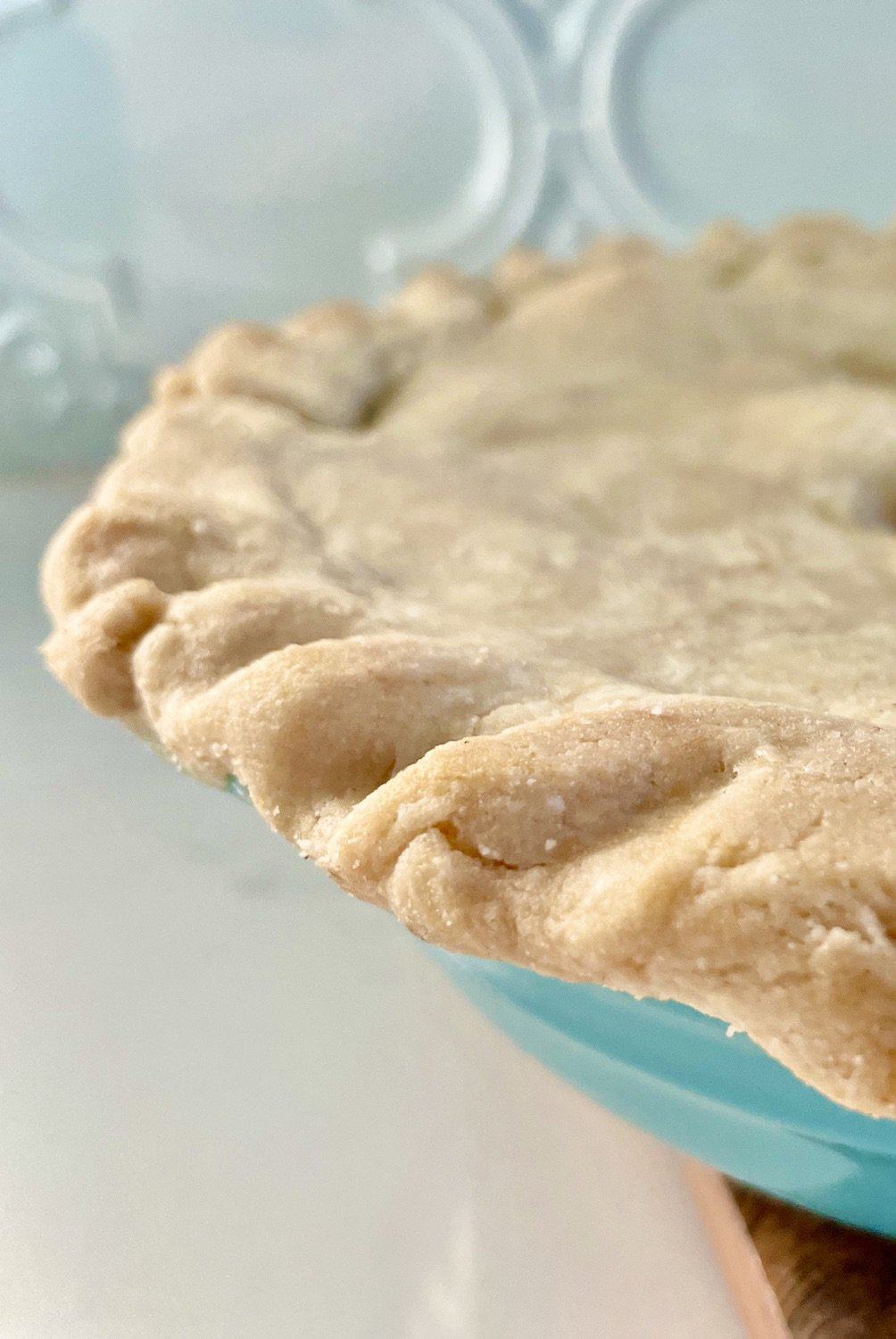

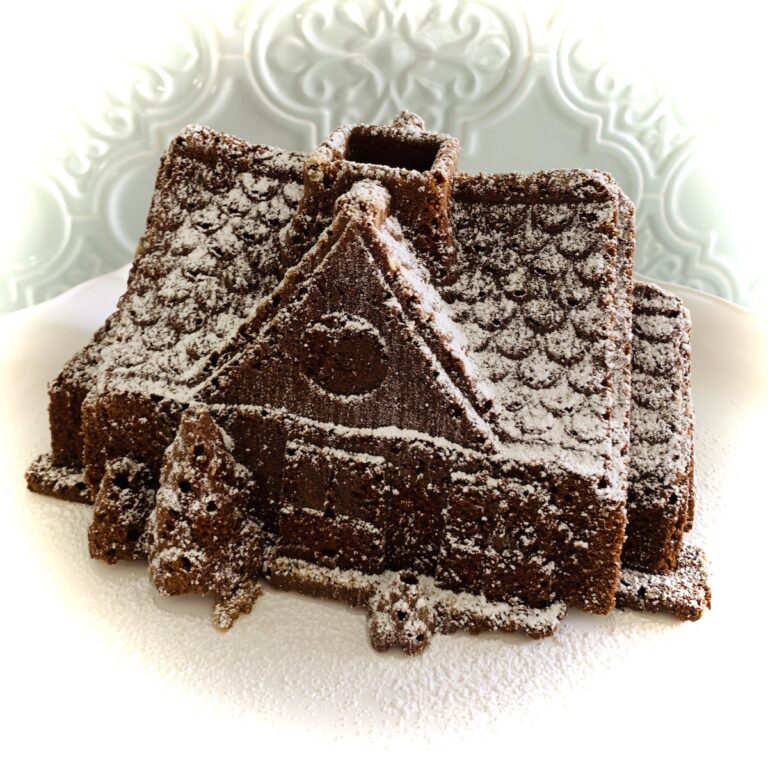

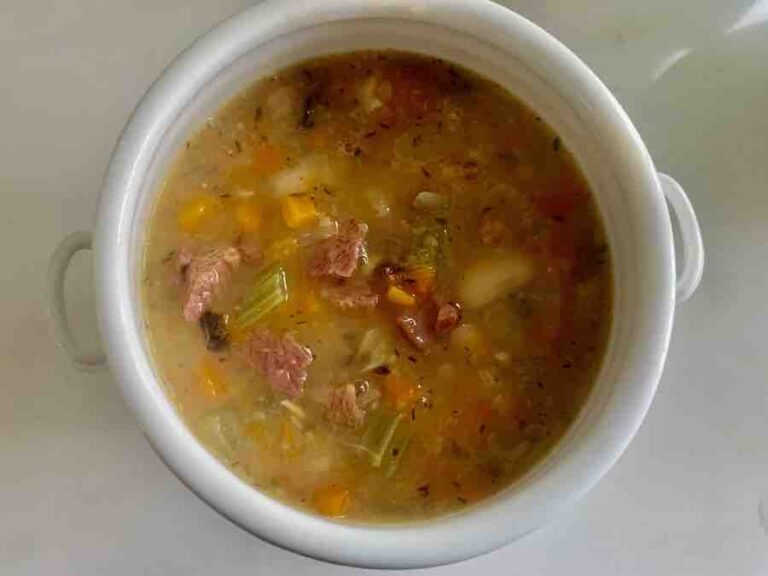
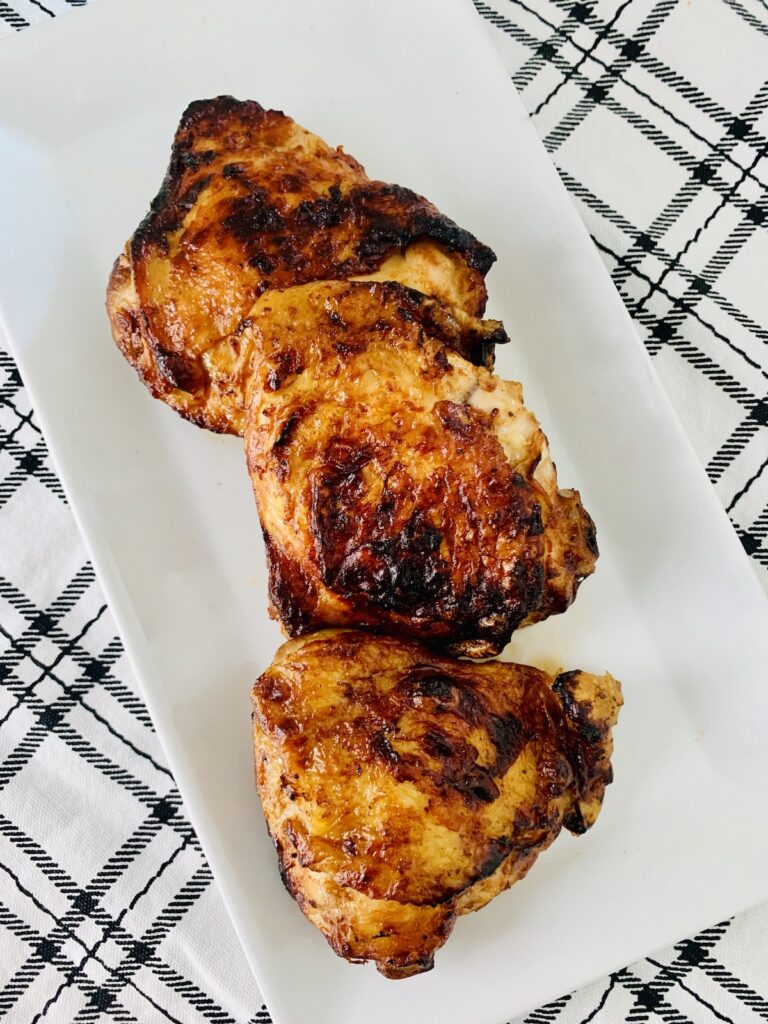
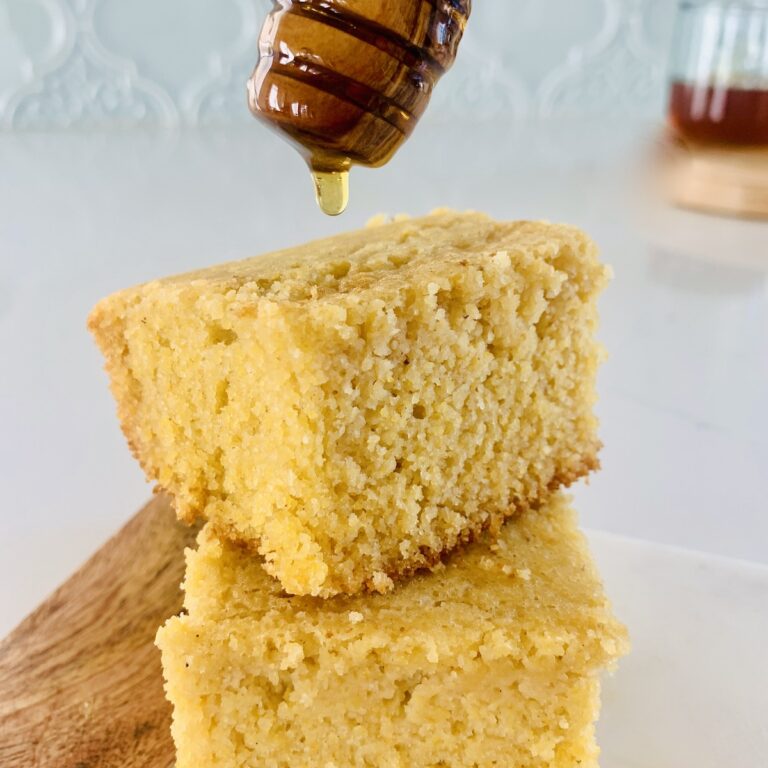
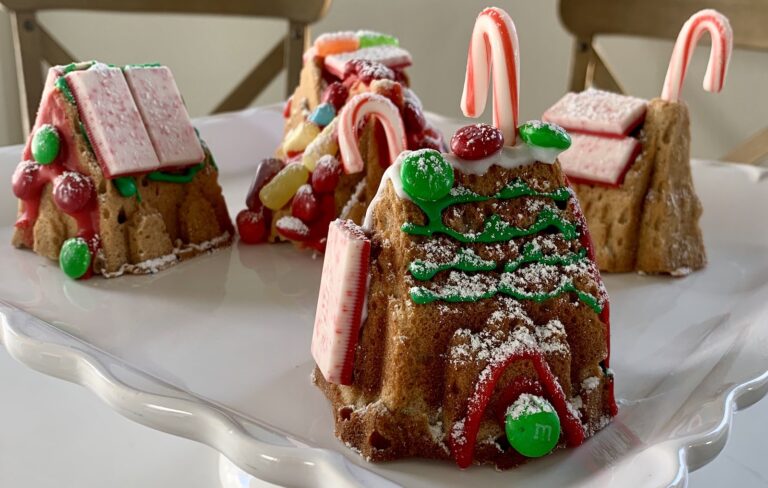
Good recipe
Thank you! Enjoy!
Do I bake the crust longer than 10 minutes if I need a fully baked crust to add a filling too?
After 10 minutes, it is only par-baked (partially-baked). If your pie filling is fully cooked, like a chocolate cream pie, after par-baking the crust for 10 minutes at 450℉, lower the oven to 400℉ and bake for about 20-25 more minutes until the edges are golden brown.